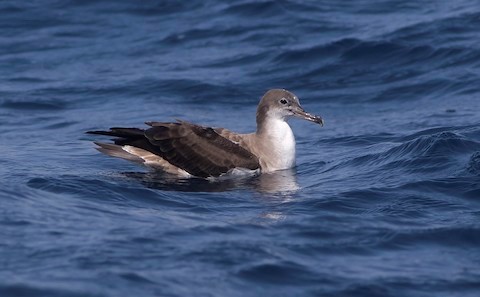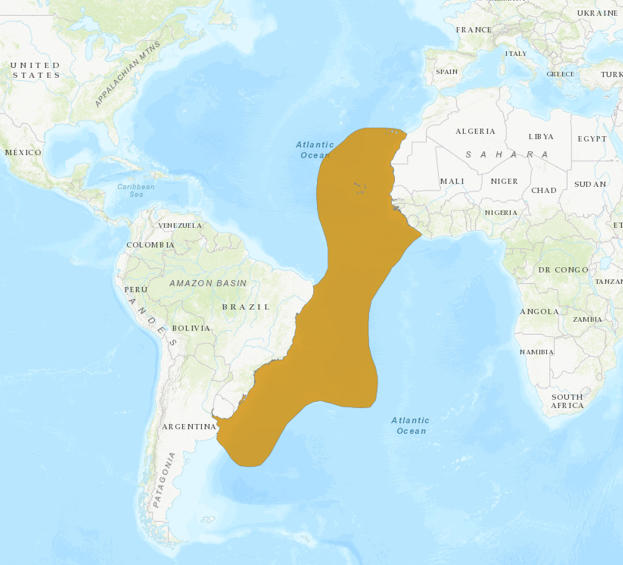Birdfinding.info ⇒ Locally common in the Cape Verde Archipelago, where it occurs year-round, but is more numerous from late February to October or November. It is most readily seen around its main nesting colony on Ilhéu Raso, which can be reached by charter boat from São Nicolau, but also regularly seen throughout the archipelago both from shore and ferries. It can often be seen on offshore trips from Senegalese ports, and sometimes from seawatch points in Dakar (especially at Les Almadies) and the ferry-accessible islands of Ngor and Gorée. In the South Atlantic it has been found most consistently in Argentine waters offshore from Mar del Plata and Mar Chiquita from late November to late February.
Cape Verde Shearwater
Calonectris edwardsii
Breeds in Cape Verde and disperses to the central and southwestern Atlantic.
Breeding. Nests colonially in crevices on cliffs and rocky islets. Arrives at colonies around late February or March, and departs around November.
More than half of the global population breeds on Ilhéu Raso (~6,500 pairs) and most of the remainder breeds on neighboring Ilhéu Branco (~3,500 pairs). There is a smaller colony on Ilhéu Bravo, and small numbers breed on mountainsides or coastal cliffs and islets of at least three of the main islands: Santo Antão, São Nicolau, and Santiago.
During the breeding season, forages largely in continental shelf and slope waters along the coast of Senegal. When feeding young, most foraging shifts to the nearshore waters of Cape Verde.
There are a few records from the Canary Islands in May and June, most from the islet Montaña Clara (northeast of Lanzarote) which could imply at least occasional breeding attempts.
Nonbreeding. From November to February, much of the population winters in offshore waters of the southwestern Atlantic from southern Brazil to central Argentina (to Chubut). It has also been recorded from these areas in April, May, and June, so some portion of the population evidently remains in the South Atlantic year-round.
Some portion of the population remains in the North Atlantic year-round as well, as small numbers are regularly recorded during the winter months from Cape Verde and Senegalese waters.
There are a few isolated records from the western North Atlantic: offshore from Maryland (October), North Carolina (August), and Guadeloupe (April). Presumably occurs in these areas somewhat more often but likely goes undetected due to its strong resemblance to Cory’s and Scopoli’s Shearwaters.
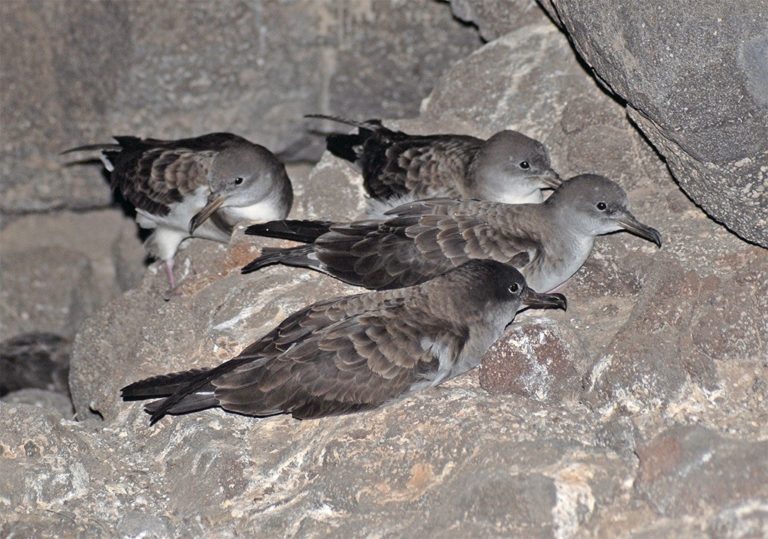
Cape Verde Shearwaters at their principal breeding colony. (Ilhéu Raso, Cape Verde; March 21, 2007.) © René Pop
Identification
A medium-large shearwater with brownish upperparts and white underparts, and a thinner, duller, grayer bill than its relatives.
Nearly identical to the more familiar, slightly larger Cory’s and Scopoli’s Shearwaters (all formerly considered a single speciess). Cape Verde averages about 10% smaller than Cory’s and 5% smaller than Scopoli’s—but each varies internally and the lengths overlap to some extent.
Cape Verde’s most consistently observable distinguishing feature is its bill, which is long and fairly thin. The coloration varies: most are pale grayish with a blackish patch or ring near the tip, but some are uniformly gray. (Cory’s and Scopoli’s both have larger, yellower bills with sharply contrasting blackish rings.)
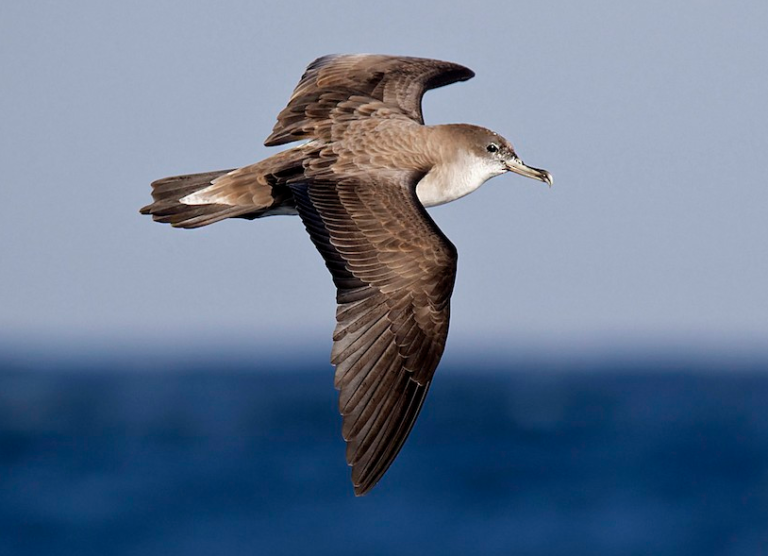
Cape Verde Shearwater, dorsal view. (Offshore between São Nicolau and Ilhéu Raso, Cape Verde; March 10, 2017.) © Daniel Lopez Velasco
The upperparts are mostly brownish, varying from sandy or pale grayish-brown from the nape to the rump, to blackish-brown on the wings and tail. The crown typically (but not always) appears darker than the nape and back. Often shows a thin, U-shaped, whitish band on the rump, around the tips of the uppertail coverts.
When viewed dorsally in flight, often shows a subtle M pattern across the wings and back. The uppersides of the primaries and tail often appear entirely blackish. The scapulars and lower-back feathers often appear mottled or dark-spotted.
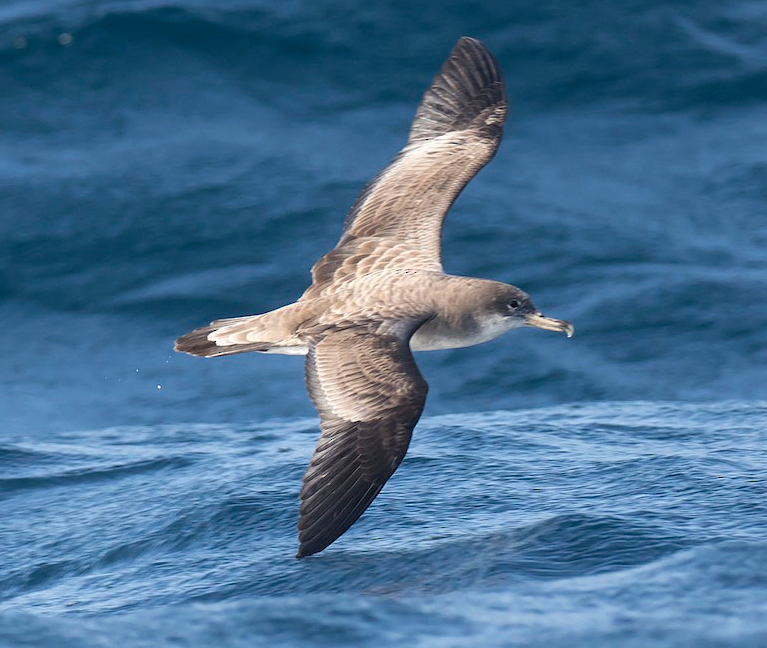
Cape Verde Shearwater, dorsal view in strong lighting, appearing mostly pale grayish-brown above. (Offshore between São Nicolau and Ilhéu Raso, Cape Verde; March 10, 2017.) © Daniel Lopez Velasco
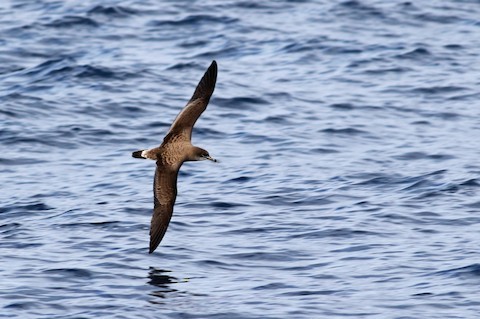
Cape Verde Shearwater, dorsal view in neutral lighting showing pronounced M pattern. (Offshore between São Nicolau and Ilhéu Raso, Cape Verde; April 12, 2018.) © Maciej Kowalski
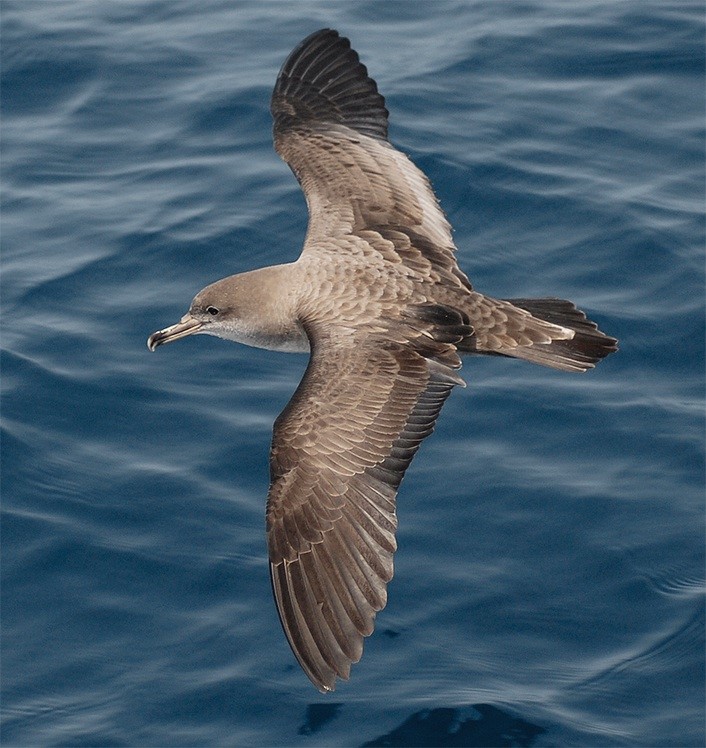
Cape Verde Shearwater, dorsal view. (Offshore between São Nicolau and Ilhéu Raso, Cape Verde; March 25, 2007.) © René Pop
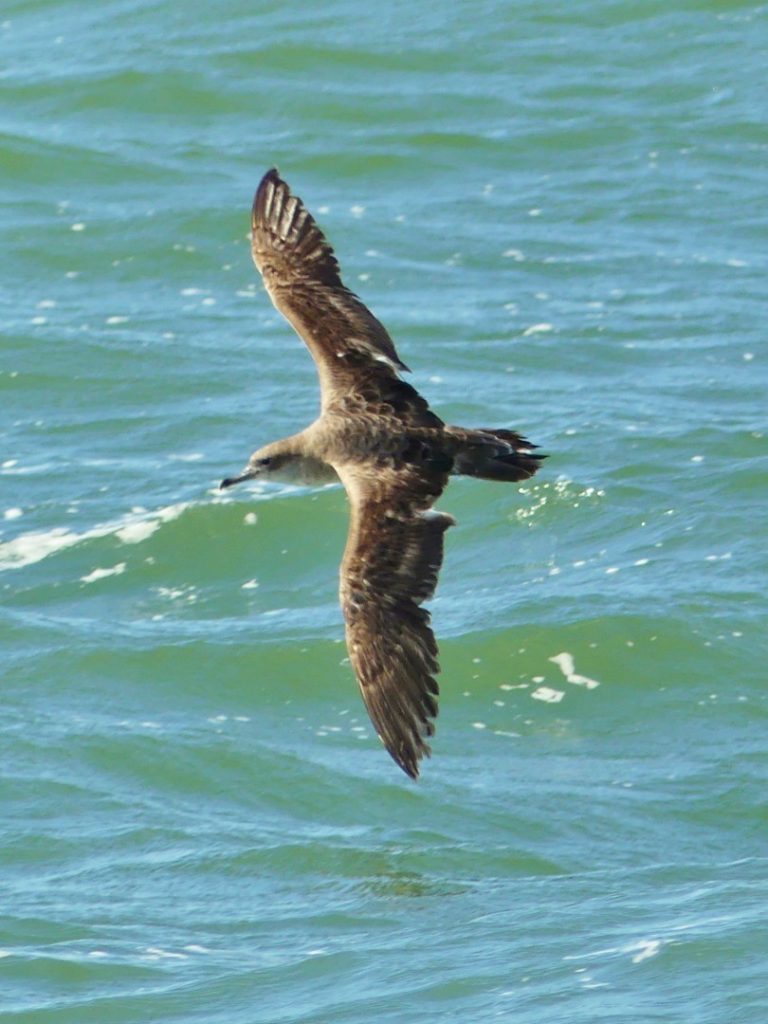
Cape Verde Shearwater, dorsal view in heavily worn plumage, appearing ragged and sandy-brown. (Offshore from Cassino, Rio Grande do Sul, Brazil; December 9, 2017.) © Gustavo Gomes

Cape Verde Shearwater, dorsal view in neutral lighting showing subtle M pattern. (Offshore between São Nicolau and Ilhéu Raso, Cape Verde; May 1, 2018.) © Robert Tizard
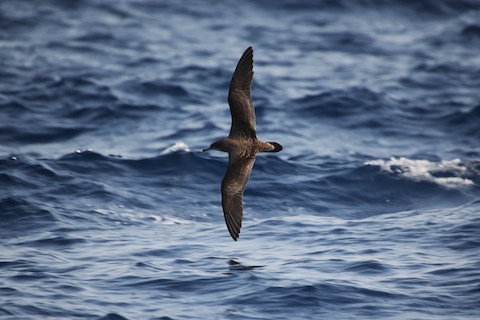
Cape Verde Shearwater, dorsal view in dim lighting, showing subtle M pattern. (Offshore between São Nicolau and Ilhéu Raso, Cape Verde; April 27, 2013.) © Paul Chapman
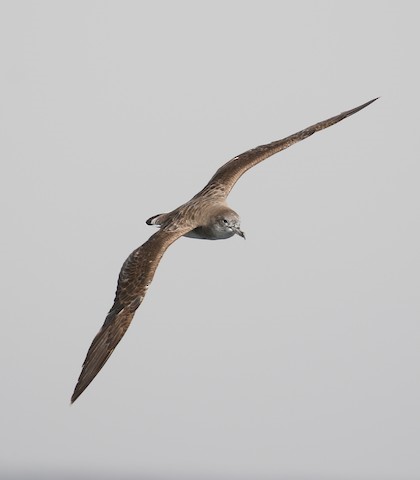
Cape Verde Shearwater. (Offshore from Dakar, Senegal; October 19, 2016.) © Marshall Iliff

Cape Verde Shearwater, ventral view showing white wing-linings and contrastingly blackish flight feathers—note bars of dark streaking along the leading edge of the wing-linings. (Offshore between São Nicolau and Ilhéu Raso, Cape Verde; March 10, 2017.) © Daniel Lopez Velasco
The underparts are mostly white except for the tail and the undersides of the flight feathers, which usually appear blackish and contrast sharply with the mostly white undertail coverts and underwing coverts (with subtle dark framing and variable streaking along the leading edge)—although in glary lighting the flight feathers may appear paler and lack the usual contrast.

Cape Verde Shearwater. (Offshore from Cassino, Rio Grande do Sul, Brazil; December 8, 2017.) © Daniel Berbare

Cape Verde Shearwater, ventral view showing white wing-linings and contrastingly blackish flight feathers. (Offshore between São Nicolau and Ilhéu Raso, Cape Verde; April 13, 2018.) © Maciej Kowalski

Cape Verde Shearwater in worn plumage, ventral view showing white wing-linings and flight feathers that appear partly whitish in this lighting. (Offshore from Cassino, Rio Grande do Sul, Brazil; December 8, 2017.) © Rafael Ritter
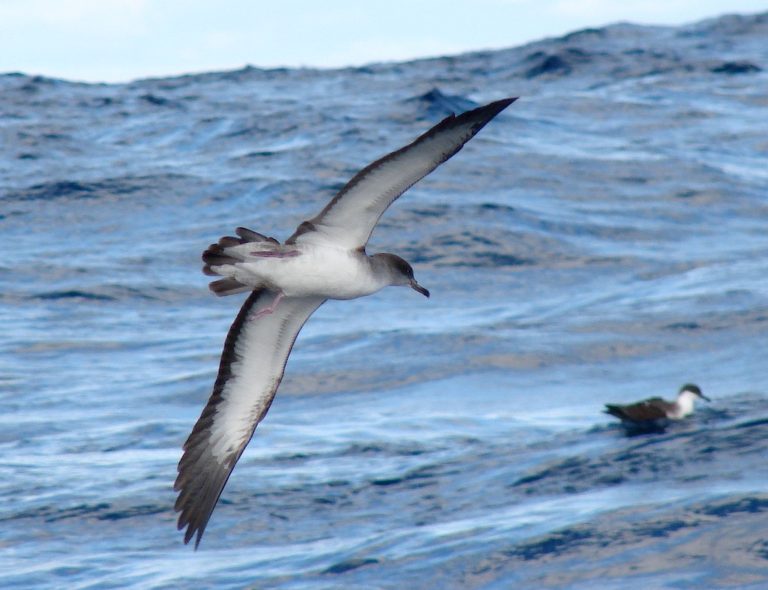
Cape Verde Shearwater, ventral view showing white wing-linings and contrastingly blackish flight feathers—also note dark crown. (Offshore from La Paloma, Uruguay; April 28, 2007.) © Martin Abreu
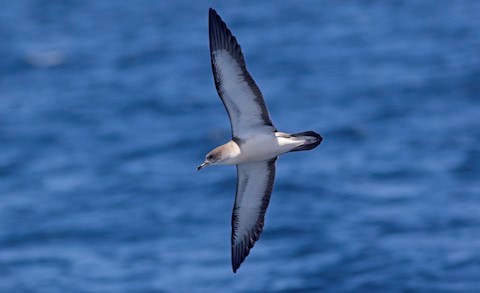
Cape Verde Shearwater, ventral view showing white wing-linings and contrastingly blackish flight feathers. (Offshore between São Nicolau and Ilhéu Raso, Cape Verde; April 24, 2019.) © Daniel Lopez Velasco
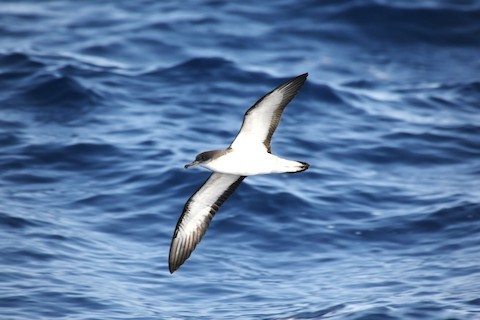
Cape Verde Shearwater, ventral view showing white wing-linings and flight feathers that appear partly whitish in this lighting—also note dark crown. (Offshore between São Nicolau and Ilhéu Raso, Cape Verde; April 27, 2013.) © Paul Chapman

Cape Verde Shearwater, ventral view showing white wing-linings and flight feathers that appear partly whitish due to the lighting. (Offshore between São Nicolau and Ilhéu Raso, Cape Verde; April 18, 2019.) © Miguel Rouco

Cape Verde Shearwater, ventral view showing white wing-linings and contrastingly blackish flight feathers. (Offshore from La Paloma, Uruguay; April 28, 2007.) © Martin Abreu

Cape Verde Shearwater. (Offshore from Dakar, Senegal; October 19, 2016.) © Marshall Iliff

Cape Verde Shearwater, ventral view showing white wing-linings and flight feathers that appear partly whitish in this lighting. (Offshore between São Nicolau and Ilhéu Raso, Cape Verde; April 24, 2019.) © Daniel Lopez Velasco
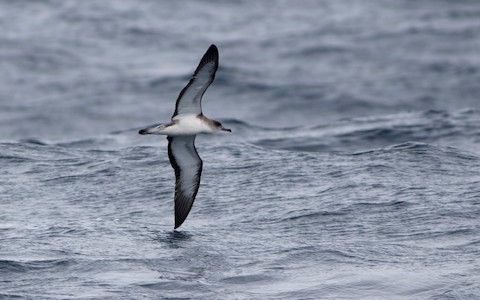
Cape Verde Shearwater, ventral view showing white wing-linings and contrastingly blackish flight feathers. (Offshore between São Nicolau and Ilhéu Raso, Cape Verde; April 24, 2019.) © Daniel Lopez Velasco
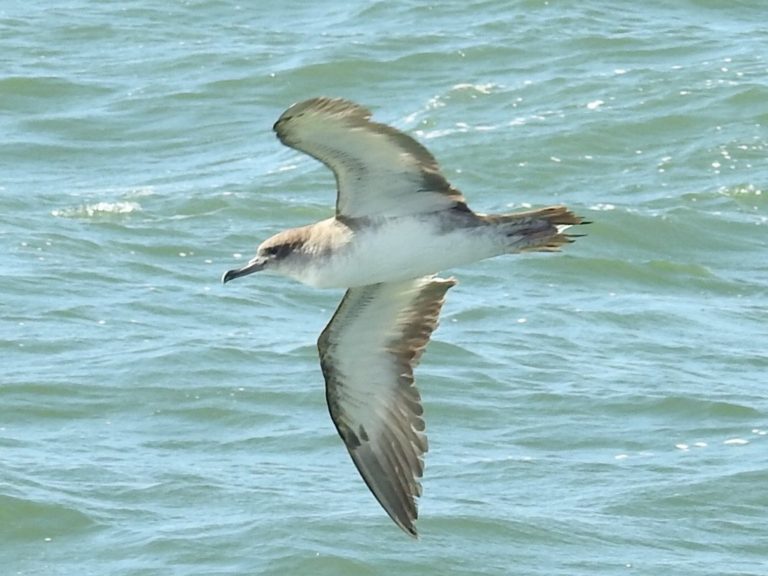
Cape Verde Shearwater in worn plumage. (Offshore from Cassino, Rio Grande do Sul, Brazil; December 9, 2017.) © Laudelino Moura Jr.

Cape Verde Shearwater, ventral view showing white wing-linings and contrastingly blackish flight feathers. (Offshore from Valdés, Chubut, Argentina; January 20, 2020.) © Mick Greene

Cape Verde Shearwater, ventral view showing white wing-linings and contrastingly blackish flight feathers—also note dark crown. (Offshore between São Nicolau and Ilhéu Raso, Cape Verde; March 10, 2017.) © Daniel Lopez Velasco

Cape Verde Shearwater, ventral view showing white wing-linings and contrastingly blackish flight feathers—also note pink legs and feet. (Offshore between São Nicolau and Ilhéu Raso, Cape Verde; April 18, 2019.) © Miguel Rouco
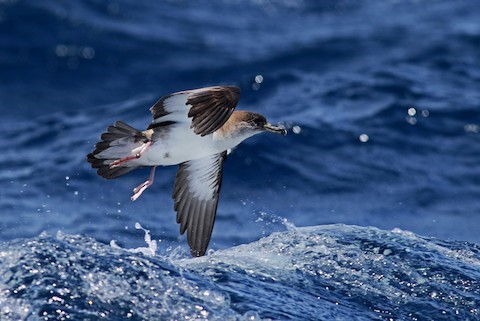
Cape Verde Shearwater, ventral view showing white wing-linings and contrastingly blackish flight feathers—also note pink legs and feet. (Offshore between São Nicolau and Ilhéu Raso, Cape Verde; April 13, 2018.) © Maciej Kowalski

Cape Verde Shearwaters, showing their underwings. (Offshore between São Nicolau and Ilhéu Raso, Cape Verde; April 13, 2018.) © Fábio Olmos
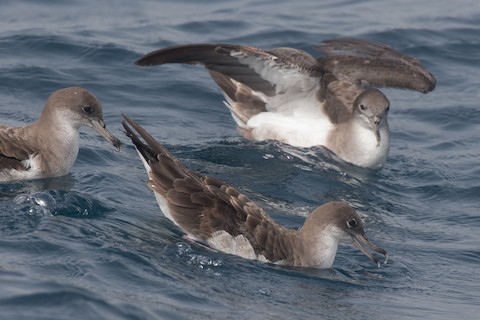
Cape Verde Shearwaters—note proportionately small heads and long bills. (Offshore from Dakar, Senegal; October 19, 2016.) © Chris Wood
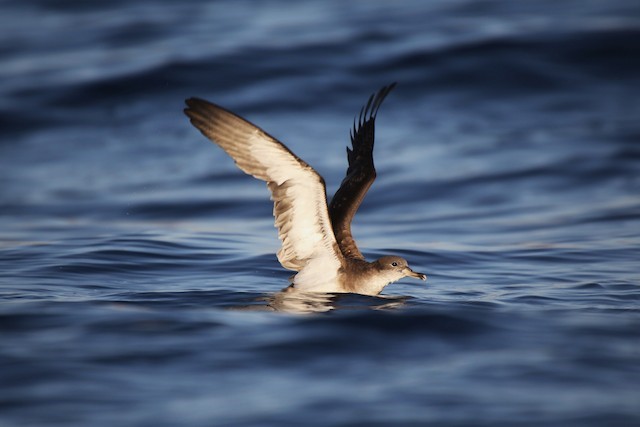
Cape Verde Shearwater, ventral view showing white wing-linings and flight feathers that appear partly whitish in this lighting. (Offshore between São Nicolau and Ilhéu Raso, Cape Verde; April 26, 2013.) © Paul Chapman
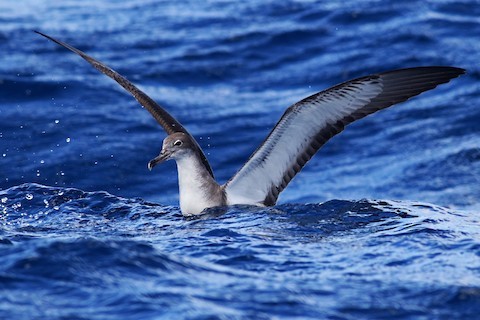
Cape Verde Shearwater, ventral view showing white wing-linings and contrastingly blackish flight feathers—note bars of dark streaking along the leading edge of the wing-linings. (Offshore between São Nicolau and Ilhéu Raso, Cape Verde; April 13, 2018.) © Maciej Kowalski

Cape Verde Shearwater. (Offshore between São Nicolau and Ilhéu Raso, Cape Verde; April 13, 2018.) © Maciej Kowalski

Cape Verde Shearwater. (Offshore from Dakar, Senegal; October 19, 2016.) © Marshall Iliff
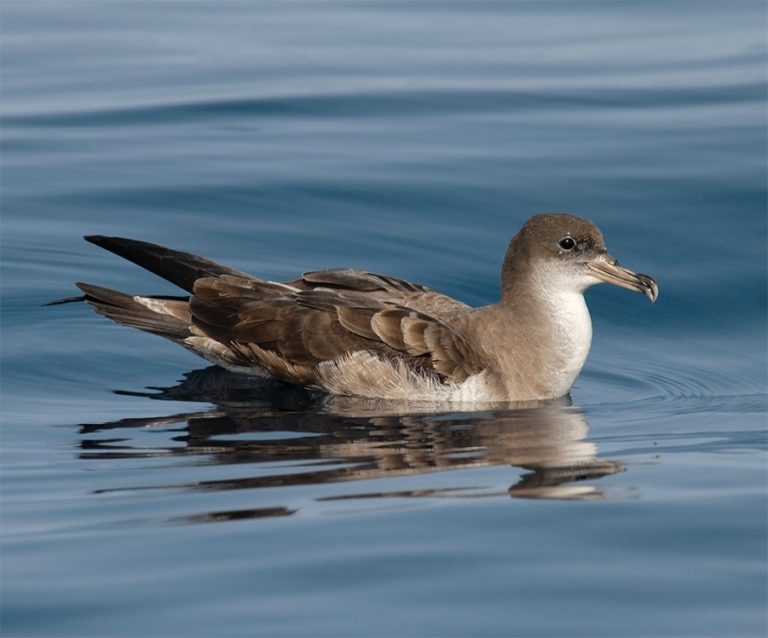
Cape Verde Shearwater. (Offshore between São Nicolau and Ilhéu Raso, Cape Verde; March 25, 2007.) © René Pop
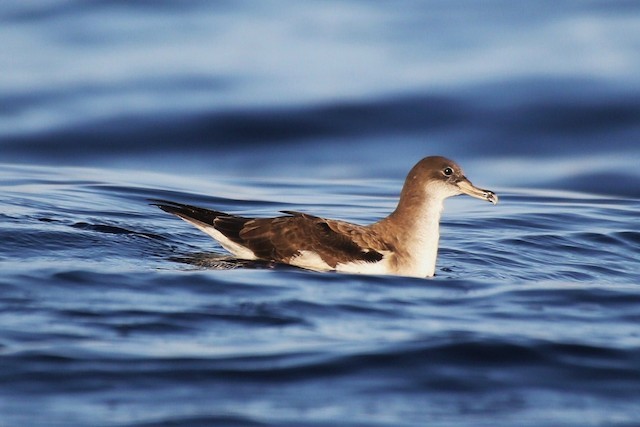
Cape Verde Shearwater. (Offshore between São Nicolau and Ilhéu Raso, Cape Verde; April 26, 2013.) © Paul Chapman

Cape Verde Shearwater. (Offshore from Dakar, Senegal; October 19, 2016.) © Chris Wood
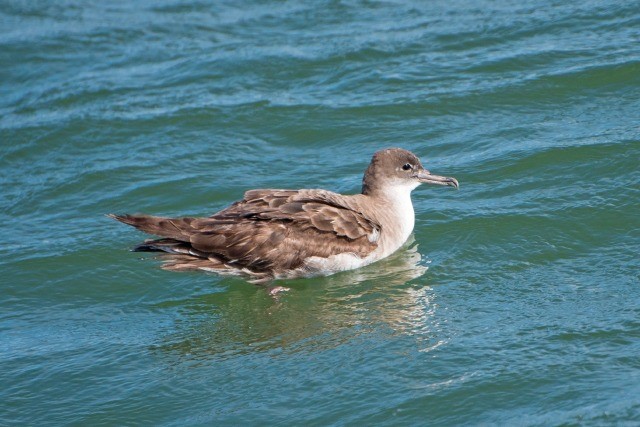
Cape Verde Shearwater, in worn plumage. (Offshore from Cassino, Rio Grande do Sul, Brazil; December 9, 2017.) © Cláudio Timm
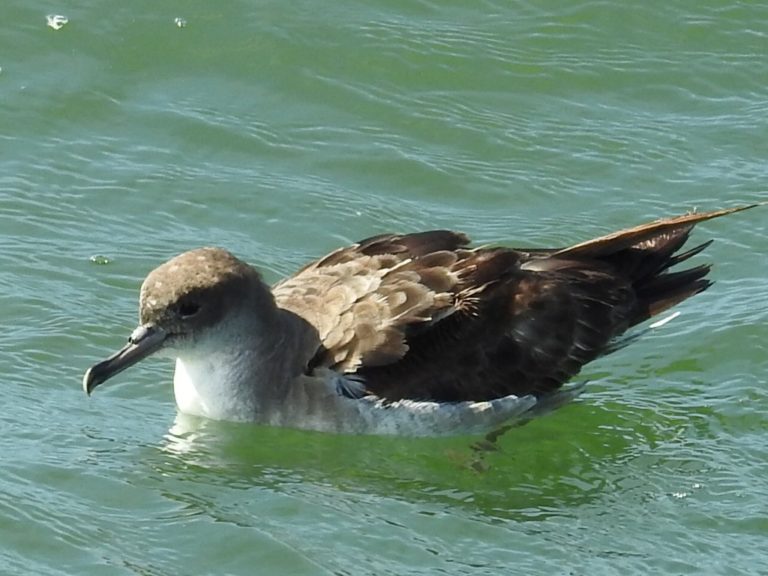
Cape Verde Shearwater, in worn plumage. (Offshore from Cassino, Rio Grande do Sul, Brazil; December 9, 2017.) © Laudelino Moura Jr.
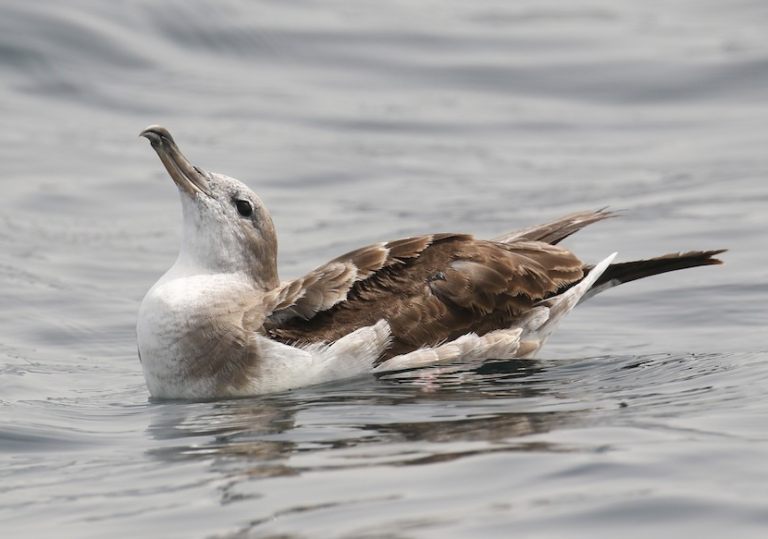
Cape Verde Shearwater, appearing unusually pale. (Offshore from Dakar, Senegal; October 19, 2016.) © Marshall Iliff

Cape Verde Shearwater with nearly uniform grayish bill. (Offshore from Cassino, Rio Grande do Sul, Brazil; December 9, 2017.) © Gustavo Gomes
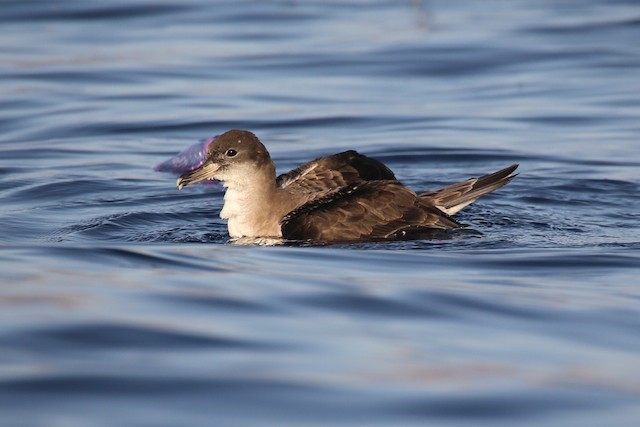
Cape Verde Shearwater, showing darker crown and indistinctly bicolored bill. (Offshore between São Nicolau and Ilhéu Raso, Cape Verde; April 26, 2013.) © Paul Chapman

Cape Verde Shearwater, on nest—a notable dusky individual with a uniformly gray bill. (Ilhéu Raso, Cape Verde; October 10, 2017.) © Domingos Leitão

Cape Verde Shearwater, on nest. (Ilhéu Raso, Cape Verde; November 14, 2009.) © Simon Davies
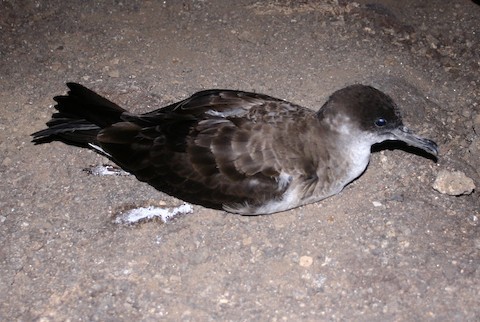
Cape Verde Shearwater, on nest, appearing dark-crowned in this lighting. (Ilhéu Raso, Cape Verde; July 13, 2009.) © Alexandre Hespanhol Leitão
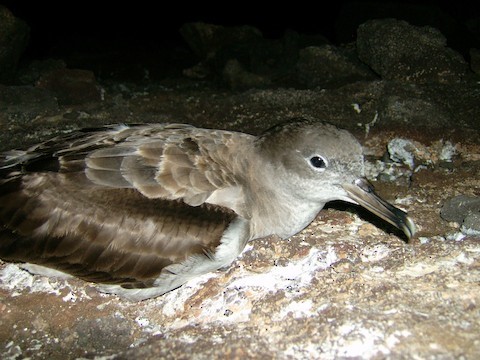
Cape Verde Shearwater, on nest. (Ilhéu Raso, Cape Verde; November 16, 2009.) © Simon Davies
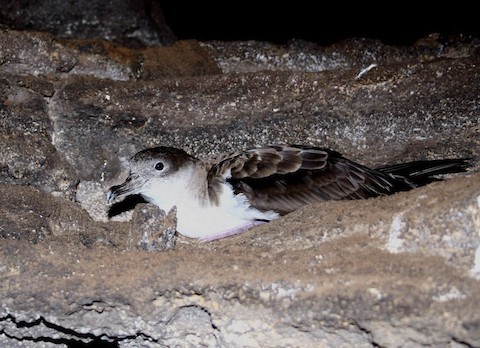
Cape Verde Shearwater, on nest. (Ilhéu Raso, Cape Verde; June 23, 2009.) © Alexandre Hespanhol Leitão
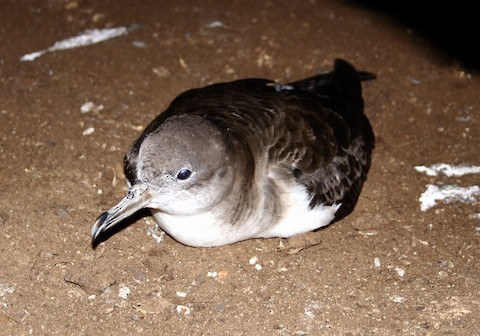
Cape Verde Shearwater, on nest. (Ilhéu Raso, Cape Verde; June 23, 2009.) © Alexandre Hespanhol Leitão
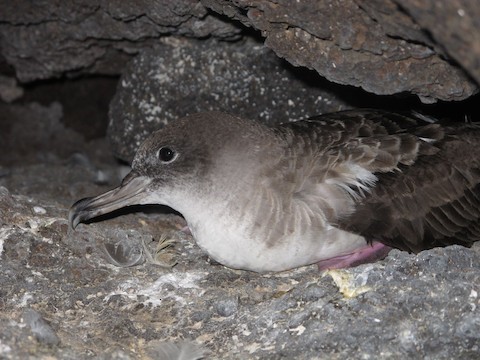
Cape Verde Shearwater, on nest—note pink foot. (Ilhéu Raso, Cape Verde; July 10, 2010.) © Miguel Lecoq
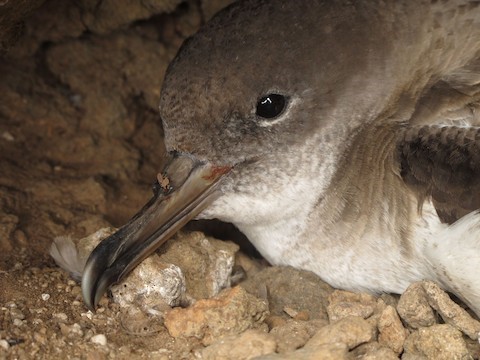
Cape Verde Shearwater, on nest, allowing a facial close-up. (Ilhéu Raso, Cape Verde; July 10, 2010.) © Miguel Lecoq
Voice. Calls at colonies resemble those of Scopoli’s Shearwater: guttural moans that alternate between quicker, higher-pitched inhalations and drawn-out, lower-pitched exhaled notes. The exhaled notes are more prominent and usually paired. (For a detailed review with recordings and sonograms, see The Sound Approach: Cape Verde Shearwater.)
Cf. Cory’s and Scopoli’s Shearwaters. Cory’s, Scopoli’s, and Cape Verde Shearwaters overlap widely, as Cory’s and Scopoli’s circulate nearly throughout the temperate, subtropical, and tropical Atlantic, and the three are so similar as to be indistinguishable unless viewed closely under good conditions. They were traditionally considered to be a single species (known collectively as Cory’s Shearwater, C. diomedea), but Cape Verde is universally recognized as separate and there is compelling evidence that Cory’s and Scopoli’s, though very similar, are separate. Genetic analysis has shown that Scopoli’s and Cape Verde are more closely related to each other than either is to Cory’s.
Scopoli’s is intermediate in size between Cory’s and Cape Verde, and differs visually in having more white on its underwings. Typical Cory’s and Cape Verde have white underwing coverts and contrasting dark flight feathers. On Scopoli’s the undersides of the outer primaries have white on the inner webs, forming a wedge that extends out from the coverts toward the tip.
Size: In length measurements, Cape Verde averages about 10% smaller than Cory’s and 5% smaller than Scopoli’s. In side-by-side comparisons, the difference between Cory’s and Cape Verde is more pronounced than the length difference alone would indicate. Cory’s is much bulkier overall. Within each species, however, males are larger than females, so differences in their average sizes can be swamped by internal variation. To add confusion, Scopoli’s’ size varies across its range (eastern breeders are smaller than western breeders) and thus overlaps broadly with both Cory’s and Cape Verde.
Bill: Cape Verde can often be identified by its bill, which is thinner, grayer, and darker overall than the others. All show a blackish patch or ring near the tip, but on Cape Verde this tends to be larger and less distinct than on the others. Unlike Cory’s and Scopoli’s, Cape Verde’s bill pattern varies widely. At one end of the spectrum, some individuals have uniformly gray bills, while at the other end, some individuals have mostly pale bills with distinctly contrasting tips, as on Cory’s and Scopoli’s.

Cape Verde Shearwater, center, with three Cory’s or Scopoli’s Shearwaters, for a comparison of overall size, head and neck coloration, and bill color and contrast. (Offshore from Cape Hatteras, North Carolina; August 15, 2004.) © Tom Johnson

Cape Verde Shearwater, at left, beside a Cory’s or Scopoli’s Shearwater—note the apparent differences in head and bill sizes. (Offshore between São Nicolau and Ilhéu Raso, Cape Verde; April 26, 2013.) © Paul Chapman
Upperparts Plumage: Cape Verde differs in its typical upperparts plumage. It tends to appear somewhat darker and grayer overall than Cory’s and Scopoli’s, and more often shows a dark crown. Although plumage alone is rarely reliable for positive identification of Cape Verde, it can be useful in some circumstances as an initial indication or to corroborate other factors.
Notes
Monotypic species. Traditionally considered conspecific with Cory’s Shearwater (borealis) and Scopoli’s Shearwater (diomedea), known collectively as Cory’s Shearwater (Calonectris diomedea).
IUCN Red List Status: Near Threatened.
References
BirdLife International. 2018. Calonectris edwardsii. The IUCN Red List of Threatened Species 2018: e.T22729421A132660464. https://dx.doi.org/10.2305/IUCN.UK.2018-2.RLTS.T22729421A132660464.en. (Accessed July 20, 2021.)
eBird. 2021. eBird: An online database of bird distribution and abundance. Cornell Lab of Ornithology, Ithaca, N.Y. http://www.ebird.org. (Accessed July 20, 2021.)
Garcia-del-Rey, E. 2011. Field Guide to the Birds of Macaronesia: Azores, Madeira, Canary Islands, Cape Verde. Lynx Editions, Barcelona.
Garcia-del-Rey, E. 2018. Birds of the Canary Islands. Christopher Helm, London.
Harrison, P. 1983. Seabirds: An Identification Guide. Houghton Mifflin, Boston.
Howell, S.N.G. 2012. Petrels, Albatrosses & Storm-Petrels of North America. Princeton University Press.
Howell, S.N.G., and K. Zufelt. 2019. Oceanic Birds of the World. Princeton University Press.
Kirwan, G.M., A. Levesque, M. Oberle, and C.J. Sharpe. 2019. Birds of the West Indies. Lynx Edicions, Barcelona.
The Sound Approach. 2019. Cape Verde Shearwater, Calonectris edwardsii. https://soundapproach.co.uk/species/cape-verde-shearwater-2/.
Wikiaves. 2021. Bobo-de-cabo-verde, https://www.wikiaves.com.br/wiki/bobo-de-cabo-verde. (Accessed July 20, 2021.)

